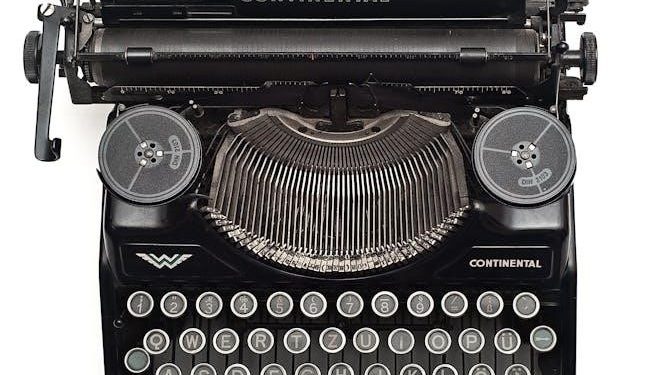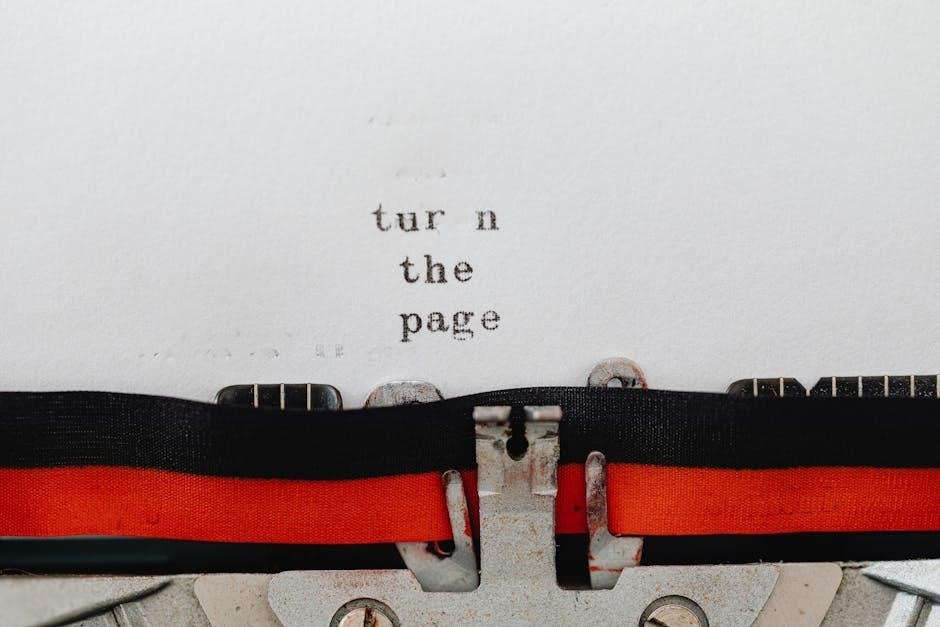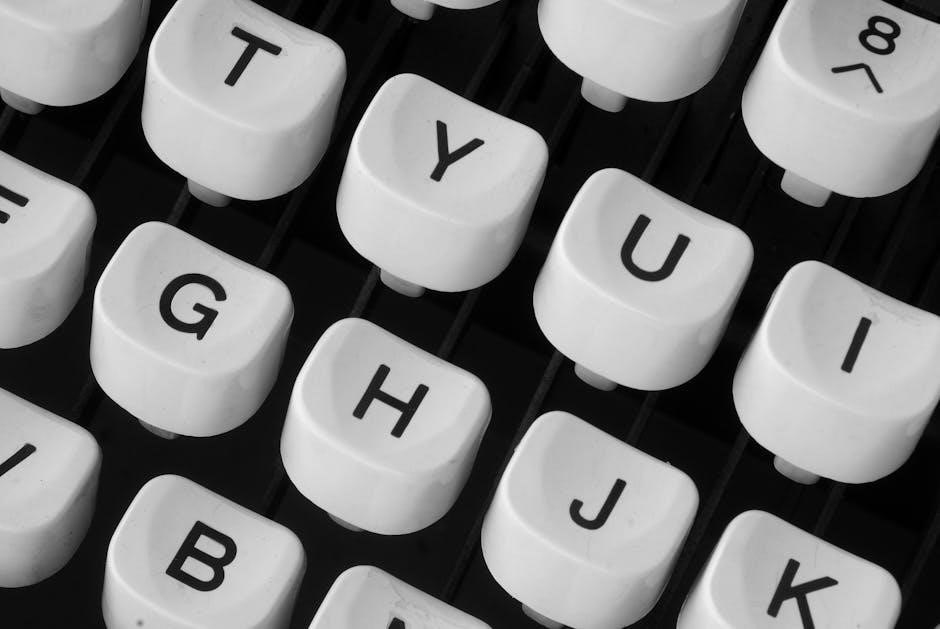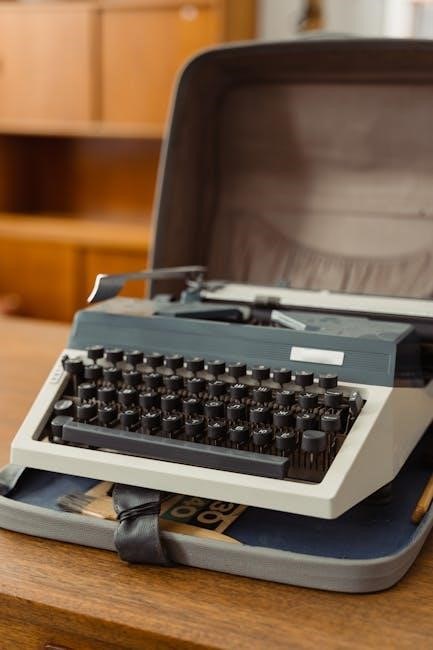
Typewriter manuals are essential guides for operating, maintaining, and repairing manual typewriters․ They provide step-by-step instructions, troubleshooting tips, and detailed diagrams․ Whether for vintage models or modern machines, these manuals are invaluable for ensuring optimal functionality and preserving the longevity of typewriters․ From brands like Remington, Royal, and Underwood to specialized repair guides, typewriter manuals cater to both everyday users and enthusiasts, offering practical advice and historical insights into these mechanical wonders․
What are Typewriter Manuals?

Typewriter manuals are comprehensive guides designed to help users understand, maintain, and repair their typewriters․ They include detailed instructions for operation, troubleshooting, and servicing, often with diagrams and step-by-step directions․ These manuals are tailored to specific models, such as Remington, Royal, and Underwood, ensuring compatibility and accuracy․ They cover mechanical theory, maintenance tips, and repair techniques, making them indispensable for both everyday use and restoration projects․ Whether for vintage or modern machines, typewriter manuals serve as vital resources for enthusiasts and collectors, preserving the functionality and heritage of these mechanical devices․
The Importance of Typewriter Manuals
Typewriter manuals are essential for maintaining and optimizing the performance of typewriters; They provide clear instructions for operation, maintenance, and repair, ensuring users can troubleshoot common issues effectively․ These guides help extend the lifespan of typewriters by offering tips for cleaning, lubricating, and replacing parts․ For vintage models, manuals are crucial for restoring functionality and preserving historical integrity․ They also empower users to perform DIY repairs, reducing reliance on professional services and saving costs․ Overall, typewriter manuals are indispensable resources for enthusiasts, collectors, and writers seeking to keep their machines in optimal working condition and maintain their timeless appeal․
Historical Overview of Typewriter Manuals
Typewriter manuals have evolved alongside the machines themselves, dating back to the 1860s when the first typewriters were developed․ Early manuals were simple, offering basic operation guidance․ As typewriters became more complex, featuring shift keys and ribbon mechanisms, manuals expanded to include detailed instructions and troubleshooting tips․ By the early 20th century, companies like Remington and Underwood standardized their manuals, often including diagrams for repairs․ With the rise of electric typewriters in the mid-20th century, manuals addressed more intricate mechanical and electrical components․ Today, vintage typewriter manuals are highly sought after by collectors and enthusiasts, preserving the history of these iconic machines․

Types of Typewriter Manuals
Typewriter manuals are categorized into user guides, repair manuals, and specialized editions, each tailored to specific needs like operation, maintenance, or vintage model care․

User Manuals for Operation and Maintenance
User manuals provide detailed instructions for operating and maintaining typewriters, ensuring optimal performance․ They include step-by-step guides for typing, setting margins, and basic troubleshooting․ These manuals are designed for everyday use, helping users understand the machine’s mechanics․ They often feature diagrams and illustrations to clarify complex processes․ Regular maintenance tips, such as cleaning and lubricating parts, are emphasized to prolong the typewriter’s lifespan․ By following these guides, users can resolve common issues independently, avoiding professional repairs․ These manuals remain indispensable for both vintage enthusiasts and modern users, offering practical advice for preserving their machines․
Repair and Service Manuals
Repair and service manuals are comprehensive guides tailored for technicians and enthusiasts to diagnose and fix complex typewriter issues․ They include detailed repair procedures, technical specifications, and parts lists․ These manuals often cover advanced troubleshooting, such as disassembling the machine, replacing internal components, and recalibrating mechanisms․ They provide schematics and diagrams to aid in precise repairs․ Unlike user manuals, repair manuals are focused on restoration and technical servicing․ They are invaluable for professionals and skilled hobbyists aiming to restore typewriters to their original functionality․ These resources ensure longevity and proper operation of the machine, even for rare or vintage models․
Specialized Manuals for Vintage Models
Specialized manuals for vintage typewriter models are tailored to address the unique needs of classic machines․ These manuals often include historical context, original manufacturers’ specifications, and detailed instructions for restoring and maintaining older typewriters․ They cater to collectors and restoration experts, providing insights into rare or obsolete components․ Many vintage manuals offer step-by-step guidance for repairing intricate mechanical systems and suggest alternatives for hard-to-find parts․ These resources are essential for preserving the functionality and aesthetic appeal of vintage typewriters, ensuring they remain operational for future generations of enthusiasts and historians․ They are a lifeline for those passionate about vintage typewriter restoration․

Key Features of Typewriter Manuals
Typewriter manuals offer clear instructions, detailed diagrams, and model-specific guidance, ensuring users can operate, maintain, and repair their machines effectively․ They are comprehensive and accessible․
Step-by-Step Guides for Troubleshooting
Typewriter manuals provide detailed, step-by-step troubleshooting guides to address common issues like jammed keys, ribbon misalignment, and mechanical malfunctions․ These guides are designed to help users identify and resolve problems efficiently, often with visual aids and clear instructions․ They empower users to diagnose and fix issues independently, saving time and reducing the need for professional assistance․ The systematic approach ensures that even novice users can navigate through solutions confidently, making these guides an indispensable resource for maintaining typewriter functionality and longevity․
Illustrated Parts and Diagrams
Typewriter manuals often include detailed illustrations and diagrams to help users understand the internal and external components of their machines․ These visuals provide a clear overview of the typewriter’s mechanics, making it easier to identify and locate specific parts․ Schematics and exploded views are common, showcasing how components interact and fit together․ This visual guidance is invaluable for maintenance, repairs, and customizations․ By providing a clear and concise representation of the typewriter’s structure, these diagrams empower users to work confidently on their devices, ensuring proper functionality and longevity․
Model-Specific Instructions
Typewriter manuals often include detailed, model-specific instructions tailored to the unique features and mechanisms of particular typewriter models․ These instructions address the distinct operational needs of each machine, ensuring users can maximize functionality․ From keyboard layouts to ribbon settings, the guidance is precise and relevant․ Model-specific instructions are essential for troubleshooting and maintenance, as they provide clarity on parts and adjustments exclusive to that model․ This personalized approach ensures users can navigate their typewriter’s quirks and capabilities effectively, making it an indispensable resource for both new and experienced typists․

Popular Brands and Their Manuals
Remington, Royal, and Underwood typewriter manuals are highly sought after for their detailed instructions and compatibility with iconic models, ensuring optimal functionality and user satisfaction․
Remington Typewriter Manuals
Remington typewriter manuals are invaluable resources for users of this iconic brand, known for its durability and innovative designs․ These manuals provide detailed operational guides, maintenance tips, and troubleshooting solutions tailored to specific Remington models․ Many vintage Remington typewriters, such as the Noiseless Portable, have manuals that include diagrams and step-by-step instructions for repair and upkeep․ Enthusiasts often seek these manuals to restore and maintain their machines․ Remington manuals are widely available in online archives, collector communities, and specialized shops, ensuring continued use and appreciation of these timeless typewriters․
Royal Typewriter Manuals
Royal typewriter manuals are essential for optimizing the performance of these esteemed machines, known for their sleek design and reliability․ Manuals for models like the Royal Portable and Royal Standard provide detailed instructions for operation, maintenance, and repair․ They often include troubleshooting guides, parts diagrams, and tips for extending the typewriter’s lifespan․ Collectors and enthusiasts highly value these manuals, as they aid in restoring vintage Royals to their former glory․ Many Royal manuals are now digitized and accessible online, ensuring their legacy endures for future generations of typewriter enthusiasts and restorers․
Underwood Typewriter Manuals
Underwood typewriter manuals are indispensable for users of these iconic machines, renowned for their durability and innovative design․ These manuals provide comprehensive guidance on operating, maintaining, and repairing Underwood models, such as the legendary No․ 5․ They include detailed troubleshooting sections, parts diagrams, and maintenance schedules to ensure optimal performance․ Many Underwood manuals are now available in digital formats, preserving their utility for modern enthusiasts․ Collectors and restorers particularly value these resources, as they offer insights into the craftsmanship and functionality of Underwood typewriters, helping to keep these vintage machines functional and cherished for generations․

Where to Find Typewriter Manuals
Typewriter manuals can be sourced from online archives, offering downloadable PDFs, specialized repair shops, and community-driven resources sharing rare and vintage guides․
Online Archives and PDF Downloads
Online archives provide convenient access to typewriter manuals, with many platforms offering free PDF downloads․ Websites like Google Books, Scribd, and Archive․org host extensive collections․ Users can search by model or brand, ensuring compatibility․ These resources are invaluable for restoring functionality to vintage machines․ Additionally, official brand websites and enthusiast forums often share scanned manuals, preserving historical documentation․ This digital accessibility has revolutionized maintenance and repair for collectors and enthusiasts, ensuring typewriter knowledge endures for future generations while reducing the need for physical storage․
Specialized Repair Shops and Retailers
Specialized repair shops and retailers are trusted sources for typewriter manuals, offering tailored solutions for enthusiasts․ These experts often provide rare manuals alongside repair services, ensuring compatibility with specific models․ Many shops cater to vintage typewriters, sourcing hard-to-find documentation․ Retailers may also supply custom parts and accessories, enhancing the utility of manuals․ By combining practical guidance with professional expertise, these shops help users maintain and restore their machines effectively․ Their services are invaluable for preserving the functionality and heritage of classic typewriters, making them a go-to resource for dedicated collectors and restorers seeking authentic, model-specific guidance․
Community-Driven Resources
Community-driven resources play a vital role in preserving and sharing typewriter manuals, fostering collaboration among enthusiasts․ Online forums, social media groups, and collaborative platforms host extensive collections of user-contributed manuals․ These resources often include digitized versions of rare and vintage manuals, uploaded by passionate collectors․ Community members frequently share tips, translations, and model-specific insights, creating a wealth of accessible knowledge․ Such platforms not only help enthusiasts maintain their typewriters but also promote the preservation of typewriter history․ They embody the spirit of shared passion and collective effort, making them invaluable for both seasoned collectors and newcomers alike․

Maintenance and Repair Tips
Regular cleaning, lubrication, and ribbon replacement are essential for optimal typewriter performance․ Proper alignment ensures smooth typing, while prompt repairs prevent mechanical damage over time․
Cleaning and Lubricating the Typewriter
Cleaning and lubricating your typewriter are essential for maintaining its performance and longevity․ Start by gently brushing dust from keys and internal mechanisms using a soft-bristled brush or compressed air․ For more thorough cleaning, dampen a cloth with water (avoid harsh chemicals) and wipe down exterior surfaces․ Lubrication should be applied sparingly to moving parts, such as hinges and pivot points, using silicone-based sprays․ Refer to your typewriter manual for specific instructions, as over-lubrication can attract dust; Regular maintenance ensures smooth operation, prevents rust, and keeps your typewriter in optimal working condition․ Clean and lubricate monthly or every 100 pages for best results․
Replacing Ribbons and Ink
Replacing ribbons and ink is crucial for maintaining clear and consistent typing quality․ Over time, typewriter ribbons wear out, leading to faded or uneven text; To replace the ribbon, turn off the typewriter and locate the ribbon spools․ Gently lift the old ribbon and remove it, then insert the new one, ensuring it’s properly seated and aligned․ For ink-based models, check if cartridges are refillable or require replacement․ Always use compatible ink to prevent damage․ Refer to your manual for specific instructions, as procedures may vary by model․ Regular replacement ensures vibrant and legible output every time․
Adjusting Alignment and Margins
Proper alignment and margin settings are essential for professional and neat typing results․ Most typewriters feature adjustable margin stops and alignment controls, typically located on the carriage or keyboard․ To set margins, move the stoppers to the desired positions and test with a trial line․ For alignment, use the keyboard’s shift or justify functions, or adjust the carriage manually․ Ensure the type aligns evenly for consistent formatting․ Refer to your manual for model-specific instructions, as mechanisms may vary․ Precise adjustments guarantee crisp, professional outcomes, making your documents visually appealing and well-organized․

Troubleshooting Common Issues
Troubleshooting is essential for resolving typewriter problems efficiently․ Common issues include jammed keys, ribbon feed malfunctions, and mechanical noise․ Refer to your manual for diagnostic guidance and solutions․
Fixing Jammed Keys
Jammed keys are a common issue in typewriters, often caused by dust, debris, or misalignment․ To fix this, turn off the typewriter and gently remove any obstructions with a small brush or screwdriver․ Lift the carriage to access the typebars and ensure they move freely․ Apply a light lubricant to hinges and pivot points․ Avoid using force, as this can damage internal mechanisms․ Regular cleaning and maintenance, as outlined in your typewriter manual, can prevent jams and keep your machine functioning smoothly․ Always refer to the manual for model-specific guidance․
Resolving Ribbon Feed Problems
Ribbon feed issues can disrupt typing, often caused by misalignment, dirt, or worn mechanisms․ To resolve this, gently lift the carriage and inspect the ribbon spools․ Ensure they are properly seated and aligned; Clean any debris with a soft cloth or brush․ If the ribbon skips or slips, check for frayed edges or uneven tension․ Adjust the spool gears as per your typewriter manual․ For persistent issues, replace the ribbon with a compatible one․ Regular maintenance and proper handling can prevent such problems․ Always follow model-specific instructions for optimal results․
Addressing Noise and Vibration
Noise and vibration issues in typewriters often stem from mechanical misalignment or worn parts․ Start by cleaning the typebars and carriage tracks to remove dirt or debris․ Check for loose screws or bolts and tighten them gently․ Lubricate moving components, such as the carriage rails, with a light oil․ Ensure the typewriter is placed on a stable, even surface․ If vibrations persist, inspect the motor or mainspring for wear․ Refer to your manual for specific lubrication points and adjustment procedures․ Regular maintenance can significantly reduce noise and improve typing smoothness over time․

The Resurgence of Manual Typewriters
Manual typewriters have regained popularity due to nostalgia, tactile experience, and artistic appeal․ Enthusiasts value the physicality of typing and the unique sound, making vintage typewriters sought-after collectibles and creative tools again․
Modern Appeal of Vintage Typewriters
Vintage typewriters have seen a resurgence in popularity, captivating modern enthusiasts with their nostalgic appeal and tactile experience․ In a world dominated by digital screens, the mechanical rhythm and physical act of typing offer a refreshing change․ Beyond functionality, these machines are celebrated for their elegant design and historical significance, serving as decorative pieces․ They also provide a unique creative outlet, appealing to writers and artists who cherish the distinct sound and feel of traditional typing, making them a cherished part of both past and present․
Collectors and Enthusiasts
Collectors and enthusiasts of vintage typewriters often seek out rare and well-preserved models, and their interest extends to the manuals that accompany these machines․ These manuals are not only essential for understanding the operation and maintenance of the typewriters but also serve as historical documents that provide insight into the evolution of typing technology․ Enthusiasts use these manuals to restore their typewriters to their original condition and to troubleshoot any issues that may arise․ The community of collectors and enthusiasts is active, with many members sharing their knowledge and resources through online forums and clubs․
Artistic and Creative Uses
Typewriter manuals have found new life in artistic and creative endeavors, transcending their practical purpose․ Artists incorporate vintage manuals into mixed-media projects, using their pages as textures or collages․ Writers and poets draw inspiration from the detailed instructions, crafting stories or poems that reflect the mechanical elegance of typewriters․ Some creators repurpose manuals as journals or notebooks, blending nostalgia with modern expression․ Additionally, manuals serve as props in theatrical performances or photography, evoking a bygone era․ Their tactile appeal and historical significance make them a unique resource for crafters and imaginative projects, bridging the gap between function and artistry․
Typewriter manuals stand as timeless guides, preserving the knowledge and craftsmanship of typewriters․ They empower enthusiasts, ensuring the legacy of these machines endures, inspiring future generations․
The Enduring Legacy of Typewriter Manuals
Typewriter manuals have left an indelible mark on the history of writing and technology․ As detailed guides, they not only aided users in operation and repair but also preserved the craftsmanship of typewriters․ Today, these manuals serve as invaluable historical records, offering insights into the evolution of typing technology․ Collectors and enthusiasts rely on them to restore and maintain vintage machines, ensuring their legacy endures․ Moreover, the rise of digital archives has made these manuals accessible to a global audience, cementing their importance as educational and nostalgic resources for future generations to appreciate and learn from․
Final Thoughts on Preserving Typewriter Knowledge
Preserving typewriter manuals ensures the survival of a bygone era’s ingenuity and craftsmanship․ As technology advances, these documents remain vital for maintaining vintage machines and understanding their historical significance․ Digital archiving has made these manuals more accessible, fostering a sense of community among collectors and enthusiasts․ By safeguarding this knowledge, we honor the legacy of typewriters and their role in shaping communication․ Educating future generations about these manuals not only preserves history but also inspires appreciation for the mechanical precision and design that defined the typewriter’s golden age․